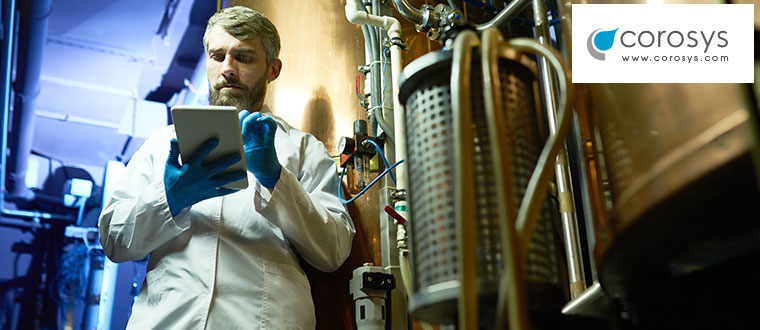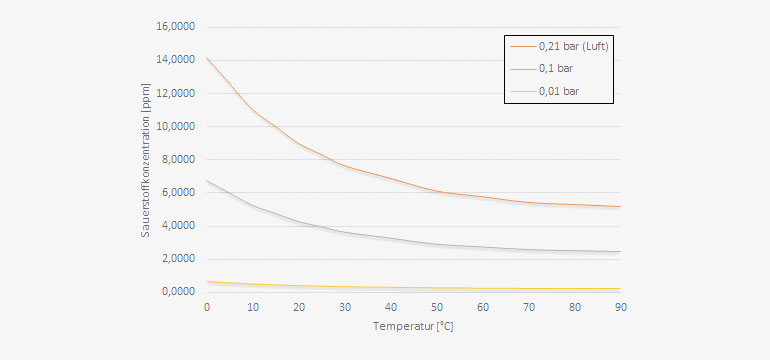Emission-free water degassing
 In the beverage and brewing industries, degassing has become an established part of water treatment. Depending on the industry and use of the degassed water, residual oxygen values below 10 ppb are required. Common to all processes in the beverage industry is the use of a stripping gas, usually CO2, in rare cases N2. A new technology from corosys does not require stripping gas or the input of thermal energy or chemicals. According to its own statements, it achieves the same low residual oxygen values as the most effective of the usual processes.
In the beverage and brewing industries, degassing has become an established part of water treatment. Depending on the industry and use of the degassed water, residual oxygen values below 10 ppb are required. Common to all processes in the beverage industry is the use of a stripping gas, usually CO2, in rare cases N2. A new technology from corosys does not require stripping gas or the input of thermal energy or chemicals. According to its own statements, it achieves the same low residual oxygen values as the most effective of the usual processes.
The otherwise essential oxygen is unwanted in most beverages. The oxidation leads to an aging taste in the product. An oxygen-free operation throughout the production process is therefore essential to minimize the negative effects of oxygen on the flavor stability of beer or other beverages. Water that comes into contact with the beer, e.g. in the case of pipe push outs, filter precoating or as blending water, therefore requires degassing.

Physical principles of degassing
Oxygen can be removed from the water by chemical or physical processes. Since chemical processes are based on the addition of a reducing agent and are therefore mostly unsuitable for the production of food, only the physical degassing will be discussed in the following.
The diagram in figure 1 shows the equilibrium concentration of oxygen as a function of water temperature and oxygen partial pressure in the gas phase. At higher temperatures the solubility decreases. For example, in ambient air with 21 percent oxygen, approx. 9 ppm oxygen dissolve in water at 20 °C. A low partial pressure shifts the equilibrium so that less oxygen is dissolved or the dissolved oxygen is released. These two relationships are used for degassing.
Stripping degassing
By injecting an oxygen-free stripping gas, the concentration of oxygen and thus its partial pressure is reduced. The shift of the phase equilibrium causes the transition of the oxygen from the water to the gas phase. In breweries CO2 is usually used as stripping gas. Since it is produced during fermentation and is also used for carbonation and other processes, it is almost always available. A frequently used alternative is nitrogen, which must be purchased or is produced from ambient air in generators. Cold water can be degassed to below 20 ppb, depending on the design of the plant. Large quantities of CO2 are required for this degassing.
Vacuum water degassing
A further possibility to reduce the partial pressure of oxygen is to lower the total pressure in the degassing vessel. This is done by using a vacuum pump. Usually liquid ring vacuum pumps are used, which can generate a vacuum of approx. 70 mbar abs. The residual oxygen content of approx. 1 ppm that can be achieved in this way can be reduced even further to values below 10 ppb by combining degassing under vacuum with a stripping gas. Compared to atmospheric stripping degassing, this process consumes significantly less CO2. The vacuum degassing systems type VWD implement this process with maximum efficiency and represent the process with the lowest CO2 consumption that can be realized so far.
Hot water degassing
By heating the water, the oxygen solubility decreases and the oxygen partially evaporates. The usual degassing temperature is 70 – 80 °C, which results in additional pasteurization. This means that it is not necessary to sterilize the water after degassing, e.g. with a UV system. The heating is done by means of a multi-stage plate heat exchanger. In a regeneration section, the already degassed hot water heats the fresh water before it is brought to degassing temperature by the heating medium. In this way, a heat recovery of up to 95 percent can be achieved. However, raising the temperature alone is not sufficient to achieve the required residual oxygen values. Similar to vacuum degassing, this process is therefore usually combined with strip degassing to achieve oxygen values below 10 ppb. Disadvantage of this process is the need for heating and cooling media as well as the heating times, advantage is the simultaneous pasteurization of the water.
Design of the degassing units
In order to make efficient use of the physical processes described above, the water in the degassing unit must be brought into contact with the gas phase in the best possible way. For this purpose, there are different designs:
Spray degassing
The simplest form is spray degassing. The water is atomized in a vessel and “rains” down on the ground. The tank can be under vacuum.
In most cases CO2 is injected into the water before it enters the vessel. This CO2 enters the vessel together with the water and serves as stripping gas. To increase the dwell time and thus the contact time, several of these vessels are connected in series. However, the CO2 consumption is very high due to the short contact time and the fast raining off.
Column degassing
The degassing column is filled with packing or structured packings made of stainless steel. These increase the surface of the water trickling down from above. The column is applicable for all three degassing processes described above. Stripping gas is fed in from below. This gas flows through the trickling water from bottom to top in countercurrent. In addition, the column can be operated under vacuum or the water can be preheated as described above.
Membrane degassing
Another type is the membrane degassing. Here, water and stripping gas are separated by a hydrophobic hollow fiber membrane. Also here residual oxygen values below 10 ppb can be achieved by cascading or serial connection of modules. A disadvantage is the limited cleanability of the membrane modules with regard to temperature and chemicals to be used as well as the lifetime specified by the manufacturer. The advantage is the lower height requirement compared to a column.

Table 1 shows the three common column degassing systems found in breweries and beverage companies. All three processes are based on stripping deaeration with CO2 or N2 in one column. Hot deaeration combines this with a previous heating of the water, vacuum deaeration stripping under negative pressure. The different types differ significantly in the amount of CO2 required to achieve the specified residual oxygen content. The consumption of CO2 is lowest with vacuum degassing at 0.3 g/l, whereas 8 times this amount is required for cold degassing.
Degassing of the new generation
Based on the three known designs of column degassing and the experience gained from 125 installed plants with a total annual capacity of 240 million hl, corosys Prozeßsysteme und Sensoren GmbH, Hofheim, has now introduced a groundbreaking further development to the market with stripping gas-free degassing (Fig. 2). It’s the high-vacuum degassing system.

By combining two stages with different pressures and an optimized flow of water and vacuum or gas streams, water is degassed to residual oxygen levels below 10 ppb at ambient temperature without prior heating and without the use of stripping gas. Both stages of the column are filled with packing elements. The packing elements used increase the surface area and significantly extend the contact time.
The first stage of the column is used for pre-degassing the water. The pressure in this part of the column is higher than the vapor pressure of the water. Due to the low ambient pressure, a large amount of dissolved oxygen is already removed from the water in this step. This stage works like the classical vacuum degassing and reduces the oxygen content to below 1 ppm.
In the second stage of the column, a vacuum is generated which corresponds to the vapor pressure of the water and is about 10 – 30 mbar abs. depending on the water temperature. In order to generate such a vacuum, a special high-performance vacuum pump is used, which is characterized by a robust design and resistance to water vapor. Now a very small part of the water evaporates and takes over the function of the stripping gas. The remaining oxygen is stripped out of the water with the steam and transported out of the column via the vacuum pump.
The new high-vacuum degassing system also has proven advantages such as maintenance-free columns and a fast start-up time. The slightly higher acquisition costs of stripping gas-free water deaeration are quickly compensated by the CO2 savings. Especially in countries with high CO2 costs this is a great advantage. With regard to the emission of the greenhouse gas CO2 , this plant is a revolution, since zero-emission is a reality in water deaeration. As an example, a larger brewery has a water deaeration plant with a capacity of 550 hl/h. With an average daily operating time of ten hours, this plant emits 60,000 kg/a CO2 directly and indirectly via the deaerated water. This represents the lowest CO2 consumption that can be achieved so far. Other processes are considerably higher. In contrast, the emissions of the high-vacuum degassing process are actually zero.
Further advantages result from the installation of the plant. Since it is not dependent on auxiliary materials, such as CO2 or a heating medium, and the exhaust gases do not have to be led outside, the amount of piping is reduced significantly.
Conclusion
The stripping gas-free cold degassing can save considerable amounts of CO2 . This makes it an extremely resource- and environmentally friendly process that can be used on a large scale. In many countries, especially in Africa, Central and South America, CO2 is a major cost factor that is completely eliminated with this water deaeration process. In addition, the process is also successfully used in areas where no CO2 is required, e.g. in combined heat and power plants for the degassing of circulating water or in the production of still beverages. The reduction of CO2 as a greenhouse gas is an elementary component of a sustainable corporate strategy.
Stephan Dittrich
Managing director corosys Prozeßsysteme und Sensoren GmbH, Hofheim am Taunus
Nadine Kollbacher
Project manager corosys Prozeßsysteme und Sensoren GmbH, Hofheim am Taunus
Jan Oertli
Project manager corosys Prozeßsysteme und Sensoren GmbH, Hofheim am Taunus
Brauwelt 36/2017